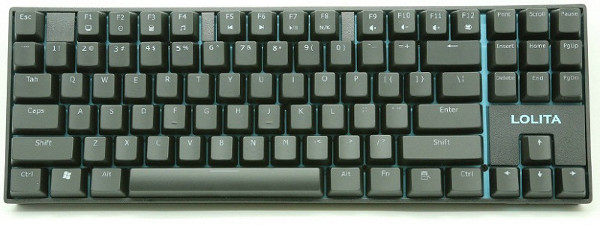|

|
I finally decided to start using a non generic keyboard, seeing as I spend my working life interacting through one. My first keyboard was quite good actually as it was a mechanical one that came with my first computer; an IBM PS/2 model 80 clone. For the last long while though, I've been using cheap generic company provided keyboards, which were OK but just not comfortable enough.
The criteria I had for a new keyboard were:
- Compact 87 keys (I never use the keypad)
- Backlit (I often code in low light)
- Mechanical keys (cherry red are my preference)
- Common layout for easy replacement etc.
Compact form factor
Having a compact keyboard is quite important for me as it allows me to easily center the keyboard against the monitor alongside a mousepad. With a full width 107 key keyboard with keypad, that was a lot more awkward given my desk space at least. Also having the keys closer together results in less stretching, and so is faster and induces less stress while typing.Back light
This keyboard is a bit cheaper without the back-light but I went with the blue back-light option as I very often code/write in low light conditions. With a standard keyboard I often get out of sync and need to peck around for a while before finding my position and get back in sync. The back-light is configurable and you cycle through modes using the Fn Up/Down keys. There are 3 intensity levels, options for lighting only a subset of the keys, and a "xmas tree mode" where the back-lights fade in and out. Personally I light all keys at the lowest level. The other LEDs on the keyboard are also cleverly integrated into the keys, with the CAPS LOCK key for example being normally unlit, and is lit in a different colour from the other keys when enabled.Mechanical keys
I suppose there is some debate as to the advantage of mechanical keys over more common ones, but personally I find the feedback more natural and easier to use. Perhaps this is due to starting to type on mechanical keyboards, but the difference is noticeable. This keyboard has options for "blue" or "red" key switches, referencing the cherry "standard", even though this keyboard uses equivalent own brand switches. You can find good references online, especially on youtube video demos, of the differences between the various switch "colours". The blue switches are more clicky which I don't like, while the red switches suit me perfectly.Key layout/keymap
I would have bought a keyboard with a UK layout if available, but an advantage to the US layout is that it's more ubiquitous and so easier to get replacements for. I'm lucky anyway that the differences between the UK and US layouts are minimal and it's easy to adjust. Now one thing I noticed with the standard US layout on GNU/Linux is that it doesn't enable the AltGr key, so I selected the "English (International AltGr dead keys)" layout to give a standard US layout, while also having easy access to keys like á and € etc.Miscellaneous
This is an NKRO keyboard, which means it can indicate an arbitrary number of simultaneously depressed keys to the system. Now this is awkward to do over USB and one needs to simulate multiple USB devices for it to work, which may cause compatibility issues with some systems. Therefore by default this mode is off and you enable with the Fn+F8 key combo. I don't need that anyway (as I don't use emacs :p) and therefore do just fine with the 6 simultaneous key presses supported in the default mode. Also provided are multimedia keys etc. which work well and without any special configuration in my Gnome 3 desktop at least. For options for further customizing your keys with PBT (rougher/stronger plastic), and padding to reduce the "clack", etc. see this useful keyboard modding video.
© Nov 24 2014